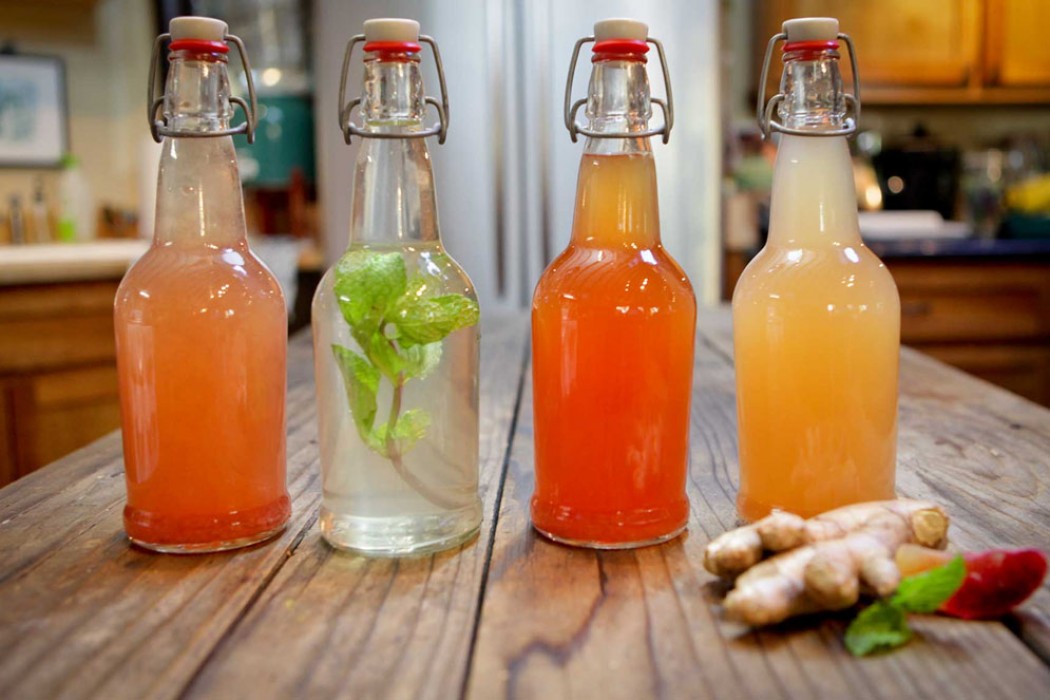It was some time ago, over a year to completely admit the extent of my procrastination, that I was working through a breezeblock of a book entitled The Art of Fermentation, by Sandor Katz, the modern Moses of the dark and mysterious process.It all sounded so fun, so magical for a guy who loves a tip of the tipple but has never made his own, and I couldn’t help but plot out my adventures in food preservation and, more so, homespun libations.Until recently, I’d never fermented anything, at least not on purpose, and it was from this privileged position that I began. Since finishing Katz’s book, I’d read horror stories of miserable failure and mushy vegetables, and I suppose they’d keep my ambition at bay. For over a year, I didn’t follow through on making the sauerkrauts and pickles or homemade wines and ciders that Katz had made seem so simple.
Fortunately for me, I ran into a need—all-natural apple cider vinegar—that I couldn’t fulfill at my local market in Guatemala. But, I could get apples, sugar and water, which is all I really need it to make it myself. From here, my physical exploration of fermentation began, and so far it has been a rewarding one and every bit as exciting as advertised in that breezeblock I thumbed through.THE PURPOSE OF FERMENTATION
I, of course, am not the only person of late to find themselves with jars of bubbling and evolving states of matter. Fermenting is quickly becoming a favorite pastime of many, for practical reasons such as food preservation but also for the health benefits as well as the flavor and fun (Remember: This is a how booze is made.). In other words, while it is an interesting hobby to adopt, it does have apparent purposes.
In years past, before the onset of canned goods and frozen dinners, fermentation was one of the main methods in which people preserved food. And, while the point was to be able to eat when production was down, the bacteria built during the process—probiotics, as now sought after by health foodies—actually do a lot of work for keeping our bodies, namely our digestive system, running wonderfully and wild. Plus, some things—bread!—just taste downright better when fermented.
MY FIRST KNOWN EXPOSURE TO FERMENTATION
Kombucha, a trendy new tea of Indian origin and reported to have a wealth of health benefits, was my first known exposure to live fermentation. I first tried the tea from a health food shop in Portland, Oregon, where I was highly doubtful that I’d ever try it again. Then, a while later, it showed up in a coffee shop where I’d go to write, and I found myself ordering it regularly, the taste (and health benefits) unlike anything I could get elsewhere.
Not long after, I volunteered at a farm where there was an ever-feeding “mother” of kombucha making healthy blends of tea. This kombucha was the best I’d ever tasted, with infusions of grapefruit and ginger and herbs. I watched the farm’s owner, incidentally the same guy who loaned me The Art of Fermentation, make his tea, and most certainly, I helped him drink it afterwards. It was simple.
Kombucha
Kombucha
HOW TO MAKE KOMBUCHA
Unlike my own fermentation experiments to come, kombucha can only be made from a mother, either acquired from a fellow fermenter or bought commercially. Making a batch of kombucha begins with dissolving sugar into hot water (about 1 cup sweetener to 12 cups of water) then steeping regular black tea. Once the water has cooled, remove the tea bags, add in either starter tea from a previous batch of kombucha (2 cups) and the komucha mother, or Scoby. It then sits undisturbed at a comfortable, shady room temperature from a week to a month fermenting. The Scoby needs to be fed to keep it alive, so it’s good practice to always have a batch brewing.
THE FIRST PROJECT OF MY VERY OWN
My wife and I have renounced the ills of the personal hygiene industry, seeking natural, DIY solutions for toiletries like deodorant, toothpaste, shampoo and conditioner. We use apple cider vinegar—by far better than the chemical stuff—for our conditioner, and it also is instrumental in controlling my waning (since getting off dandruff shampoos) dry scalp issues. When we couldn’t find it anywhere, I knew it was time to try my hand at making it.
Permaculture News has published a full-fledged account of this adventure, but in short, to get to apple cider vinegar, one must first make hard apple cider, the boozy beverage. The alcoholic cider is then left alone until it turns to vinegar, a much-improved version of what we’d been buying in stores. Suffice it to say, I took into account the fact that I’d want to at least have a pint or six of cider from my first batch and doubled my quantities.
As promised, it all worked wonderfully. The hard cider was delicious and worked well for a dab of dizziness, and the apple cider vinegar works like a charm in the shower, as well as tastes fantastic in the kitchen (It can also be used for all-natural cleaning products). I started another batch immediately after the first was finished and got the same results.
Hard-Apple-Cider
Hard Apple Cider
HOW I MADE APPLE CIDER VINEGAR
Get a large glass container or crock and fill it a little over halfway with pieces of apple—skins, seeds and all—about a couple centimeters or more cubed. Add in water and sweetener (I used sugar) at the ratio of four liters to 250 milliliters. Fill the container up to a couple of inches from the top and cover it with a breathable cloth. For the first week, stir it vigorously once a day. Bubbles from fermentation will start to be obvious within a couple of days. At the end of the week or thereabouts, it will be cider. For vinegar, just let it sit another three weeks or a month until the alcohol turns.
INSPIRATION STRIKES AND SUCCEEDS AGAIN
The inspiration for my next fermentation project actually came from a different book, Cooked, by Michael Pollan, famous for his activism and his ground-breaking publication called The Omnivore’s Dilemma. In Cooked, he explores preparing food with fire, water, air and earth. Ironically, though the earth section is all about fermenting, it was the air section and Pollan’s training in bread-making that prompted my next adventure: A sourdough starter from scratch.
A Plant’s-Eye View-Michael Pollan
From this book and further investigation, I learned that sourdough is not just superior in taste to typical bread, but it is also much healthier. The fermentation process helps with our digestion of wheat, taking out much of the issues with glutton that people are beginning to worry over. What’s more, a DIY sourdough simply harvest wild yeasts from the air and world around us rather than require store-bought, processed, and singular leavening agents.
I’d only ever heard of starters with air of fear. They were something that people labored to maintaining, feeding them every day or else. They were something that were seemingly so complicated that people didn’t bother making from scratch and, instead, just bought ready-made starters. I was scared going in. A week later, I was munching down on a hunk of sourdough made from my starter and absolutely delicious. And, I felt like a fool for not having done it all sooner.
HOW I MADE A SOURDOUGH STARTER
It’s flour and water, and it’s pretty much just that simple. Most recipes, including Pollan’s account, call for measurement by weight, as professional bakers would do. My but-I-don’t-have-a-kitchen-scale recipe called for two parts volume flour (one cup) to one part water (half a cup) in volume. By weight, they should be equal. Once a day, I added the same mixture to the original, stored in an old pickle jar. Wild yeast began to congregate in the mixture, making bubbles and alarming aromas. Five days in, it smelled like sourdough as I know it. I started making bread, no yeast needed, simply flour, water, a pinch of salt, and sourdough starter.
Sourdough-Starter-(photo-by-Jim-Champion)
Sourdough Starter
ONE MORE TIME FOR GOOD MEASURE
My latest adventure in fermentation was ginger beer, a slightly alcoholic and home-brewed version of that Canada Dry stuff we’ve all had on airplanes. I’m a huge advocate of ginger, a magically medicinal plant with powers beyond many prescription drugs. Anyway, we can get it into our diet is a plus, and even more so when that method is refreshing beverage on a summer’s day.
I must admit straight off that I’ve not done this one quite the way I plan on doing it in the future, but the results were undeniable and delicious. It is possible—and probably recommended—to make a ginger bug, similar to the kombucha Scoby or sourdough starter. However, for my first batch, I skipped this step and used some yeast already in the cupboard. I’ll tell you how to do both.
I made the quick and easy ginger beer by grating a quarter cup of ginger (a bit more than my recipes suggests), adding a half cup of sugar (a bit less than suggested) and making it into syrup by dissolving the sugar into heated water. This ginger syrup can then be an even quicker ginger ale by combining it with soda water. But, I wanted to ferment it, so I added the cooled mixture to two liters of water, a quarter cup of lime juice and one-eighth of a teaspoon of active dry yeast. From there, it takes two or three days.
Ginger-Beer-(photo-by-Laura-Burns)-
Ginger Beer
HOW TO MAKE GINGER BUG
Making a ginger bug is much like making a sourdough starter, the point is to collect wild yeast by constantly adding something for eat to feed on. For a ginger bug, you should start with about three tablespoons of grated ginger, another three tablespoons of white sugar, and a couple cups of water. Add one tablespoon of grated ginger and one of sugar a day for a week, at the end of which it should be a ginger bug. A good bug smells a bit yeasty and sweet and will be cloudy.
I can’t wait to do more. Fermentation has lived up to it’s billing thus far, with tasty treats that have seriously impressed my friends and family. And, either I am extremely fortunate, or it is easy even for beginners. I’ve got sauerkraut on the horizon, as well as kimchi and some more fermented fruit beverages from kitchen scraps (just compost them after getting yet another use out of the fruit—how permaculturally multi-functional!). I hope these recipes and tales are of some use to others, perhaps given a few readers the confidence and know-how to give it a go.


